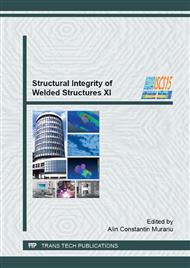p.25
p.31
p.37
p.43
p.49
p.56
p.62
p.67
p.73
Structural Analysis for Joining Dissimilar Thin Sheets with CMT (Cold Metal Transfer) Process
Abstract:
The work includes work steps for joining thin sheets with a thickness ranging from1.0 mm (according to EN10327-2004). The study presents the following steps: problems arising from joining with CMT weld-brazing process of galvanized low-carbon steel sheets, used as filler material CuSi3. This is due to the fact that copper induces: grain refinement by lowering the transformation temperature and precipitation hardening after rapid cooling and tempering the theoretical and experimental study of these problems leads to the possibility of combining copper with iron. This is an experiment to investigate the formation of interlayer containing intermetallic compounds, inter layer located between the molten material and the base material. An important part of the study was the optimizing of weld-brazing parameters: welding current, welding speed and dynamic correction factor Ina.Keywords: galvanized sheets steel, joining, weld-brazing CMT, preserving the zinc layer, intermetallic layer.
Info:
Periodical:
Pages:
49-55
Citation:
Online since:
July 2015
Authors:
Price:
Сopyright:
© 2015 Trans Tech Publications Ltd. All Rights Reserved
Share:
Citation:


